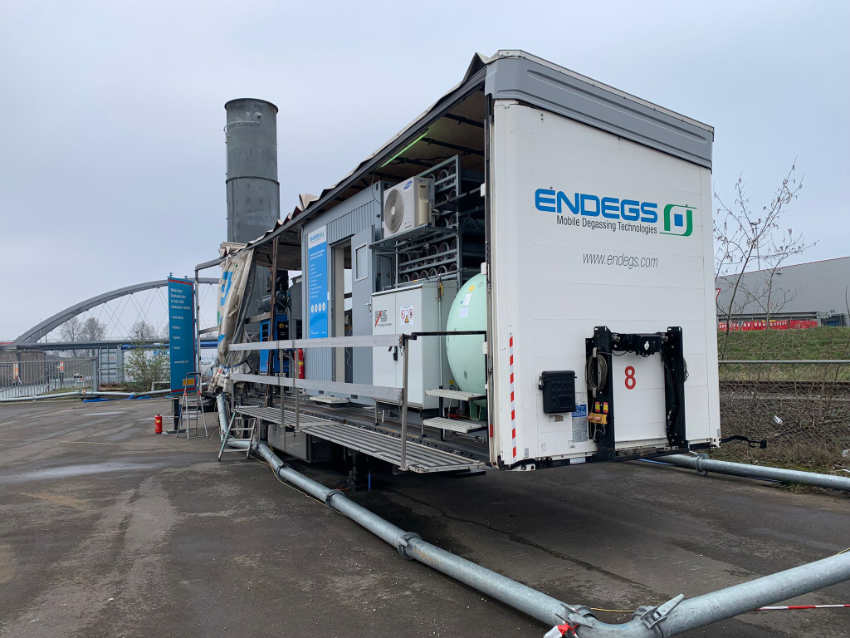ENDEGS GmbH, as a brand company of the ETS Group and international expert in industrial emission reduction and degassing, has received the approval for a barge degassing site in the Port of Duisburg in the fourth quarter of 2023 in accordance with the BImSchG (Federal Immission Control Act). Since the summer of 2018, vessels have already been degassed throughout the port area. Four years ago, ENDEGS GmbH then leased a permanent site in the Port of Duisburg, the largest inland port in the world, and initiated the corresponding approval procedures to legalize the first degassing site for shipping on the Rhine. Now that the site for inland barge degassing has also been officially put into operation, motor tankers and gas tankers can be degassed on the site on the Rhine in compliance with ADN.
The ENDEGS GmbH barge degassing site covers an area of almost 4,000 square meters and is an important part of environmentally-friendly operations in Duisburg’s inland port. It is still common practice in many places to ventilate vessels into the open air or to release vapors from barge cargoes, which is harmful for both the environment and local residents. Until the opening of the ENDEGS barge degassing site, there was also no way to properly dispose of residual gases from tankers in the Port of Duisburg. Since March 2020, a mobile combustion chamber from ENDEGS has been permanently stationed in the Port of Duisburg for the degassing of inland vessels. The incinerator system burns gases, gas mixtures and vapors of the explosion groups IIA, IIB and IIC in an environmentally-friendly manner without an open flame, odorlessly and with an efficiency of more than 99.99 %.
“Degassing inland vessels is very important, for example for maintenance and repairs on the vessel or for loading new substances – after all, all tanks must be completely gas-free for these processes. In our barge degassing site, we offer the first legal option for the environmentally-friendly degassing of inland barges and vessels in Germany in order to dispose of residual gases and liquids properly and sustainably”, says David Wendel, Managing Director of ENDEGS GmbH and Managing Director and CCO of ETS Group GmbH. “We are delighted that we have now been able to put our degassing site into operation after receiving the official approval. After setting up our barge degassing site over four years ago, this is now the next step towards even more environmentally-friendly operations in the world’s largest inland port. The degassing site is centrally located in the Port of Duisburg and plays an important role in optimizing the disposition of vessels, barges and tankers. Thus, shipping companies as well as their customers in the petrochemical and chemical industries can benefit.”
Purging station completes the barge degassing site in the Port of Duisburg
Purging is an important process when handling substances that are highly flammable and pose a high risk of explosion. These substances include, for example, liquefied gases under pressure such as LNG, ammonia, hydrogen or liquid gas. In order to work safely with components that contain these substances, they must be purged. Reactions such as oxidation can lead to deflagration or explosion inside the tank – therefore, unwanted substances like oxygen must be displaced from the tank. This can be achieved by purging and inerting – the addition of so-called inert gases that do not react with other substances.
Purging and inerting are also advantageous for degassing, as the gas or liquid can be pressed out of the container with an inert gas as a medium and fed into the combustion chamber, where it is combusted in an environmentally-friendly manner. In the barge degassing station set up by ENDEGS GmbH in the Port of Duisburg, nitrogen is used for the degassing of inland vessels.

Purging station increases safety and environmental protection
“As an inert gas, nitrogen is ideal for purging gases and liquids”, says David Wendel. “We have therefore added a purging station to our barge degassing site in the Port of Duisburg and are permanently providing both a combustion chamber and a nitrogen vaporizer for degassing and purging on our premises in Duisburg.”
“We are very happy about the official commissioning of the degassing station in the Port of Duisburg and the subsequent vessel degassing”, says Norman Gerlach, Managing Director of ENDEGS GmbH and Managing Director and COO of ETS Group GmbH. “The combination of combustion chamber and nitrogen vaporizer enables us to work safely with components that contain substances like LNG, hydrogen or liquid gas, as well as their degassing. With the units permanently stationed in the Port of Duisburg, we can offer the first site for the environmentally-friendly degassing of motor tankers and gas tankers on the Rhine.”
The first vessel to be degassed after commissioning was a motor tanker with a preload of pentene.
Technologies for the reduction of harmful emissions
The ETS Group is a provider of technologies and services for a sustainable environment and was formed in 2023 through the merger of ENDEGS GmbH with SIS GmbH. Both companies are experts in mobile emission reduction and degassing and have been helping their customers to reduce harmful industrial emissions for more than 17 years. This enables industrial facilities from various sectors such as oil, gas, chemical and petrochemical to make their operations and maintenance more sustainable and contribute to environmental protection.
In addition to mobile degassing, SIS and ENDEGS also offer the temporary replacement of stationary emissions reduction systems such as vapor recovery units (VRU) as well as the safe remote-controlled cleaning of industrial tanks. The technology portfolio of the ETS Group brand companies includes almost 50 mobile vapor combustion units, a fleet of mobile vaporizers with nitrogen tanks, blowers certified for the ATEX Zone 0 and an ATEX Zone 0 robot for safe tank cleaning.

